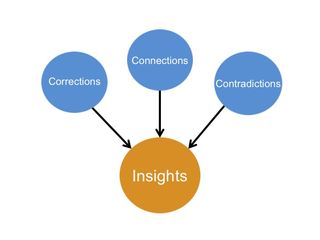We all know the feeling of getting stuck: we need to solve a problem but we don’t see any daylight. Maybe the problem is unsolvable, but maybe, just maybe, there is a way out. Unfortunately, try as we may, we can’t find it.
Chess players face this challenge several times in a single game. They even have a name for the discovery when it comes — creative desperation.
However, getting past an impasse isn’t always a game. In 1949 Wagner Dodge led a team of smokejumpers who got trapped by a forest fire in Montana. They raced as fast as possible uphill, but the fire was rapidly gaining on them and Dodge realized his team could never outrun it. Then he had an insight. Looking at the heavy dry grass all around him he realized that he could set a fire that would burn the grass ahead, depriving the fire of fuel. Barely a minute before the forest fire engulfed him, he used his canteen to wet his handkerchief, held it over his face, dived into the ashes of the escape fire he had started, and saved his life.
Aron Ralston faced a life-or-death impasse when his right hand became trapped by a small boulder that pinned him to the side of a canyon. He spent several days, hoping someone would rescue him but no one came. He used his knife to try to chisel a gap between the boulder and the canyon wall and pull his hand free, to no avail. Out of food, out of water, weak with exhaustion he made the decision to cut off his hand, severing his forearm, in order to escape from the trap. But by now his knife was too dull. He couldn’t cut through the bone. He was done for. He threw a small involuntary tantrum, flailing around, and as he flailed he noticed the bone in his arm bend. And in that instant he realized that he didn’t have to cut through the bone — he could snap it! His insight let him escape from his canyon trap.
Most psychological studies of insight rely on impasse problems. Not the life-and-death kind, but small impasses that fit into a laboratory, like the two-string problem: finding a way to join two strings that are hanging from the ceiling but are too far apart. Most subjects in these kinds of experiments get stuck and stay stuck, failing to notice the pair of pliers lying on the ground, along with other items such as a book of matches, an extension cord, and some books. The subjects don’t see that they can tie the pliers to one of the strings and get it swinging while they take hold of the other string. But some subjects have the insight and use the pliers to solve the problem.
In my book Seeing What Others Don’t: The remarkable ways we gain insights, I pointed out that these kinds of impasse situations weren’t the only path to insight. We also achieve insights by noticing connections and contradictions. In fact, in the sample of 120 real-life insights that I studied, this creative desperation path, as I called it, was much less frequent than the other two.
Nevertheless, impasse problems can be very important — as we see in the Wagner Dodge and Aron Ralston examples. This path is the only one of the three insight paths in which the person is deliberately searching for a solution. What can we learn from people who have succeeded? To investigate this path further, I went back to the 120 insight examples I had compiled, and identified 25 incidents of impasses that got overcome. I added two more that weren’t part of the original sample (Aron Ralston was one), for a total of 27.
Looking through the 27 cases for a common theme, I found one: the impasse was created when the person asked the wrong question. The insight came when the person replaced the original question with a better one. Wagner Dodge was fixated on outrunning the forest fire, but the life-saving question was how to keep the fire from engulfing him. Aron Ralston was fixated on using his dull knife to cut through his bone, but the life-saving question was how to separate portion of bone connected to his hand from the portion connected to his elbow.
The wrong question leads to unnecessary assumptions; the better question avoids these assumptions. (the escape fire, the snapping of the bone). Advocates of critical thinking programs suggest we should list all of our assumptions in order to spot the unnecessary ones, but usually the assumptions trapping us are ones we make unconsciously, and it is hard to list unconscious assumptions.
The shift to a new question often includes a shift to a higher-level goal: not getting engulfed by fire rather than outrunning the fire, disconnecting the forearm bone rather than cutting through it.
When we shift to a better question we spot leverage points we hadn’t noticed before: the escape fire, the snapping of the bone. In fact, seeing the leverage point is part of the process of shifting to the new question. When Aron Ralston threw his tantrum he noticed the bone in his forearm bending, which was the hint he needed to re-cast his question.
Hints are very important. A total of 18 out of the 27 impasse incidents depended on people noticing hints that suggested a better question and a new leverage point. We can't just will ourselves to shift questions — we need to be open to hints. So one suggestion for handling impasses is to adopt an active, curious mindset to increase the chance of noticing these hints. Even for toy problems like the two-string task, researchers found that if they “accidentally” brushed against one of the strings and set it swinging, that hint helped a lot of the subjects change from the question of how to grasp both strings to the better question of how to get one of the strings to swing — at which point they noticed the pliers.
Two other impasse incidents out of the 27 I studied were solved by a “shake the tree” strategy of finding a way to probe the situation to uncover an essential hint. The protagonists in these incidents manufactured their own hints.
For 5 of the 27 impasse incidents, the solution was to shift to a better question but I couldn’t detect any hint in the account of the incident. The Wagner Dodge incident fell into this category. The idea of an escape fire just came to him. Perhaps as he was running through the grass he thought how much quickly he could run if he didn’t have the grass slowing him down, which might have given him a hint about removing the grass and thereby removing the fuel for the fire. But that’s just my own speculation.
In the final two impasse incidents, the person adopted a skeptical mindset. In one case, the person tried to make an argument for a belief that was opposite to one she was holding. The other case involved a computer technician who systematically worked through every facet of the system to find why an internet connection had failed — along the lines of the critical thinking program of listing and testing assumptions.
Therefore, I am revising the Triple Path model of insight. Two of the paths, the Connection path and the Contradiction path, described what people did to gain insights: they made connections or they spotted contradictions. The third path, the one I am exploring in this essay, named the dilemma, a need for creative desperation, but didn’t explain the strategy. Now I have a better appreciation of how people handle impasse situations — by replacing an ineffective question with a better one. So we can call this the Correction path.





